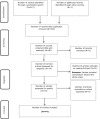A systematic review of economic evaluations of cervical cancer screening methods
- PMID: 35945642
- PMCID: PMC9361672
- DOI: 10.1186/s13643-022-02017-z
A systematic review of economic evaluations of cervical cancer screening methods
Abstract
Objective: The aims of this systematic review were to (1) identify primary- and model-based economic evaluations of cervical cancer screening methods and to (2) provide a contextual summary of valuation outcomes associated with three types of cervical cancer screening tests: visual inspection with acetic acid, human papillomavirus deoxyribonucleic acid, and Papanicolaou smear.
Introduction: Cervical cancer screening is an important public health priority with the potential to improve the detection of precancerous lesions in high-risk females for early intervention and disease prevention. Test performance and cost-effectiveness differ based on the specific screening method used across different platforms. There is a need to appraise existing economic evaluations of cervical cancer screening methods.
Methods: This review considered primary-based and model-based full economic evaluations of cervical cancer screening methods. The evaluation methods of interest included cost-effectiveness analysis, cost-utility analysis, cost-minimization analysis, cost-benefit analysis, and cost-consequence analysis. We searched Scopus, PubMed, National Health Economic Evaluation Database (NH EED), Cochrane, and the Health Economic Evaluation Database for full economic evaluations of cancer screening methods. No formal date restrictions were applied. Model-based and primary-based full economic evaluations were included. A critical appraisal of included studies was performed by the main investigator, while a second independent reviewer assessed critical appraisal findings for any inconsistencies. Data were extracted using a standardised data extraction tool for economic evaluations. The ultimate outcomes of costs, effectiveness, benefits, and utilities of cervical cancer screening modalities were extracted from included studies, analysed, and summarised.
Results: From a total of 671 screened studies, 44 studies met the study inclusion criteria. Forty-three studies were cost-effectiveness analyses, one study reported both cost-utility and cost-effectiveness outcomes, and another study reported cost utilities of cervical cancer screening methods only. Human papillomavirus (HPV) DNA testing was reported as a dominant stand-alone screening test by 14 studies, while five studies reported visual inspection with acetic acid (VIA) as a dominant stand-alone screening test. Primary HPV screening strategies were dominant in 21 studies, while three studies reported cytology-based screening strategies as the dominant screening method.
Conclusions: Existing evidence indicates that HPV-based and VIA testing strategies are cost-effective, but this is dependent on setting. Our review suggests the limited cost-effectiveness of cytology-based testing, which may be due in part to the need for specific infrastructures and human resources.
Systematic review registration: PROSPERO CRD42020212454 .
© 2022. The Author(s).
Conflict of interest statement
The authors declare that they have no competing interests.
Figures
Similar articles
-
Economic evaluation of policy options for prevention and control of cervical cancer in Thailand.Pharmacoeconomics. 2011 Sep;29(9):781-806. doi: 10.2165/11586560-000000000-00000. Pharmacoeconomics. 2011. PMID: 21838332
-
[Health technology assessment report: Computer-assisted Pap test for cervical cancer screening].Epidemiol Prev. 2012 Sep-Oct;36(5 Suppl 3):e1-43. Epidemiol Prev. 2012. PMID: 23139174 Italian.
-
Prevention of cervical cancer in HIV-seropositive women from developing countries through cervical cancer screening: a systematic review.Syst Rev. 2018 Nov 17;7(1):198. doi: 10.1186/s13643-018-0874-7. Syst Rev. 2018. PMID: 30447695 Free PMC article.
-
Cervical cancer screening program based on primary DNA-HPV testing in a Brazilian city: a cost-effectiveness study protocol.BMC Public Health. 2020 Apr 28;20(1):576. doi: 10.1186/s12889-020-08688-4. BMC Public Health. 2020. PMID: 32345284 Free PMC article.
-
Factors Influencing the Cost-Effectiveness Outcomes of HPV Vaccination and Screening Interventions in Low-to-Middle-Income Countries (LMICs): A Systematic Review.Appl Health Econ Health Policy. 2020 Oct;18(5):641-654. doi: 10.1007/s40258-020-00576-7. Appl Health Econ Health Policy. 2020. PMID: 32468410
Cited by
-
Cost-effectiveness of single-visit cervical cancer screening in KwaZulu-Natal, South Africa: a model-based analysis accounting for the HIV epidemic.Front Oncol. 2024 Apr 24;14:1382599. doi: 10.3389/fonc.2024.1382599. eCollection 2024. Front Oncol. 2024. PMID: 38720798 Free PMC article.
-
Maximizing the cost-effectiveness of cervical screening in the context of routine HPV vaccination by optimizing screening strategies with respect to vaccine uptake: a modeling analysis.BMC Med. 2023 Feb 10;21(1):48. doi: 10.1186/s12916-023-02748-3. BMC Med. 2023. PMID: 36765349 Free PMC article.
-
Reply to: “Comments on the article entitled “Primary ADN-VPH screening in women under 30 years of age: health technology assessment”.Rev Colomb Obstet Ginecol. 2023 Mar 30;74(1):92-94. doi: 10.18597/rcog.4015. Rev Colomb Obstet Ginecol. 2023. PMID: 37093934 Free PMC article. English, Spanish. No abstract available.
-
Bridging the gap in cervical cancer screening for underserved communities: MCED and the promise of future technologies.Front Oncol. 2024 Jul 29;14:1407008. doi: 10.3389/fonc.2024.1407008. eCollection 2024. Front Oncol. 2024. PMID: 39135996 Free PMC article. Review.
References
-
- Boardman HC. Cervical Cancer . 2019. Available from: https://emedicine.medscape.com/article/253513-overview
-
- Bouassa RM, Prazuck T, Lethu T, Meye J, Be’lec. Cervical cancer in sub-Saharan Africa: an emerging and preventable disease associated with oncogenic human papillomavirus. Available from: https://www.ncbi.nlm.nih.gov/pubmed/28406406 - PubMed
-
- Ministry of Health Lesotho . Guidelines for screening for cervical precancer in Lesotho. 2012.



